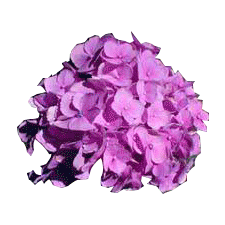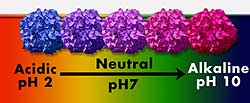Color Changes of Hydrangeas
How can soil change the color of a hydrangea
bush?
From what you learned previously about hydrangeas, how do you think
soil conditioning and chemistry apply to gardening?
The chemistry of soil is the key to color changes in a hydrangea bush!
The condition of the soil is important to the health of your plant.
Most plants like soil that is rich in nutrients. That is why you or
your parents might add fertilizer to your garden or the grass in your
front yard. Not only are the nutrients found in the soil important,
but the pH is also important, especially to the flowers of your hydrangea.
Recall that hydrangeas can bloom in assorted colors from white to pink
to blue. White flowers typically signify that the hydrangea is still
young.
| Blue flowered hydrangeas require soil
to be slightly acidic, ranging from a pH of 5.0 to 5.5. Aluminum
minerals should also be present in the soil by adding aluminum sulfate
commonly found in fertilizers. |


|
Pink flowered hydrangeas require soil to be more basic,
ranging from a pH of 6.0 to 6.4. At this pH level, the hydrangea
is also less able to absorb aluminum minerals from the soil if they
are present. |
 To
Background Chemistry
To
Background Chemistry
